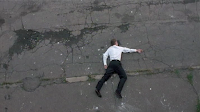059. The Creeper aka Rituals (1977)

Director: Paul Carter
Writer: Ian Sutherland
From: Drive-In
Watch: archive.org
Five doctors venture into the Canadian wilderness for their annual retreat only to find themselves being systematically stalked and killed.
Normally this is the part where I expand on the plot blurb, but there's actually nothing to expand upon. That one sentence is the entirety of the movie, and it's a pretty good flick.
The five doctors are flown out to a part of the woods called the Cauldron of the Moon, a canyon that legend says was formed by the moon striking the Earth and bouncing off. The doctors are cut off from civilization, miles from where the plane dropped them off, and the plane itself isn't coming back for six days because what could possibly go wrong?
They end up bickering the first night over issues of medical ethics and what each one should be pursuing career-wise as well as mistakes they've made with patients. The next morning, they wake up to find all their boots have been stolen. Since only the man who organized the trip packed an extra pair of shoes, he strikes off alone to find a dam upriver and get help. That night, the other four doctors find a freshly killed deer wrapped in a snake outside their camp and decide to follow their friend to the dam. As they make their way upriver, they start encountering various threats and, one by one, get hurt or killed.
The film itself is pretty smart. The character motivations make sense with moments of selfishness, anger, regret, and there's a palpable tension throughout, both from their stalker and from nature itself. The characters take turns having their moments of lucidity and there's a sense that the movie is more a character study examining personal moralities rather than some half-baked slasher film with pretensions of a moral core (*cough* Saw *cough*).
The Mill Creek version is apparently a TV cut, so no gore or profanity, but I didn't feel the lack. I thought this was going to be something really stupid and it turned out to be one of the more compelling movies I've watched from these sets. There's a copy on archive.org, although I don't think the movie's PD. A commenter there even notes that this likely falls under GATT. Regardless, it's not difficult to find online with a quick Google of “The Creeper 1977” or it's alternate title, “Rituals 1977.” An unequivocal recommend, though.
060. Anatomy of a Psycho (1961)

Director: Boris Petroff
Writer: Jane Mann and Don Devlin from a story by Jane Mann
From: Pure Terror
Watch: archive.org
Chet Marco, after his brother Duke is executed for murder, becomes obsessed with getting revenge upon those who sent Duke to the chair.
A pretty uninspired crime drama with “Psycho” in the title only because Psycho had been such a success the year before. The execution that pushes our titular psycho over the edge doesn't happen until fifteen minutes into the seventy-five minute movie, and the courtroom drama of the conclusion takes just about as long. His reign of terror is limited to beating up the D.A.'s son, beating up the judge's son and then burning down his house, and finally framing the key witness's son for murder. For being obsessed with getting revenge against those who convicted his brother, Chet does spend a lot of time just being a bully instead.
The script allegedly had some input from Ed Wood, and there are elements that speak to his exploitation aesthetic—overt moralism, sassing kids getting their comeuppance, vague homoerotic subtext (although that may describe everything made from about 1939 until Stonewall). There is a central ideological flaw to the movie: Chet is insane for believing in his brother's innocence despite a court's ruling, but then uses that very court system to get the son of the key witness convicted of murder. So the movie's saying Chet is insane for believing the courts are fallible, and then shows those very courts being used to wrongly convict someone.
There's also the Lieutenant who reads as a crooked cop, but is actually an honest cop, but then breaks into Chet's house and threatens him with the need to be afraid when a cop starts breaking the law, and then sits back and watches an old man break in to that very house. That cop is the one who talks Chet down at the end and takes him away to get psychiatric help. So what the hell is he?
The movie offers some fun: Chet is perhaps the whiniest psycho ever placed on screen, the cop isn't so much crooked as laughably incompetent, and, of course, all these “teenagers” started drawing Social Security as soon as filming wrapped. It's neither unwatchable nor remarkable except for how very little they do with their central concept. Had it pushed things further, it'd have been more fun and maybe even a forgotten camp classic. As it is, it's cheap b-movie product, decidedly extant but hardly exploitative.
This film's in the public domain and I've added an MPEG2 copy to archive.org.










